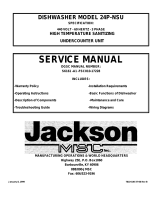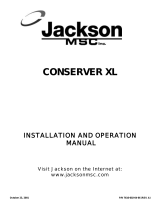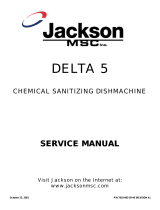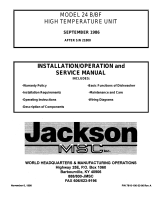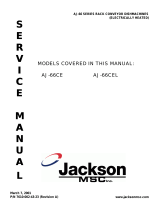Page is loading ...

DELTA 5-E
INSTALLATION, OPERATION,
AND SERVICE MANUAL
Delta 5-E Manual • 07610-003-37-08-L
DELTA
®
SERIES GLASSWASHER DISHMACHINES
®

MANUFACTURER'S LIMITED WARRANTY
(APPLICABLE ONLY IN THE UNITED STATES AND CANADA)
WARRANTY REGISTRATION:
To register your Jackson Dishmachine’s warranty go to www.jacksonwws-warranty.com or call 1-888-800-5672. Failure
to register the Dishmachine will void the warranty.
ONE YEAR LIMITED PARTS AND LABOR WARRANTY
For a period of one (1) year from date of original installation of a new Jackson Dishmachine (but in no event to exceed
eighteen (18) months from date of shipment from Jackson’s factory), Jackson WWS, Inc. (Jackson) will repair or replace,
at its discretion, any original part that proves defective in materials or workmanship at the time the Dishmachine was
purchased; provided that (i) the Dishmachine has not been altered, (ii) the Dishmachine has been properly installed,
maintained, and operated under normal use conditions and in accordance with the applicable installation, operation and
service manual available on the Jackson website, and (iii) a warranty claim is reported to a Jackson Authorized Service
Agency within the warranty period. This warranty includes replacement with Jackson specied genuine replacement parts,
purchased directly from a Jackson Authorized Parts Distributor or Service Agency. Use of generic replacement parts may
create a hazard and shall void this warranty.
THIS WARRANTY DOES NOT APPLY OUTSIDE THE UNITED STATES AND CANADA.
Jackson will pay the labor to repair or replace a defective original part as a part of the warranty, provided that a Jackson
Authorized Service Agency performs the labor. Any repair or replacement work by anyone other than a Jackson
Authorized Service Agency is the sole responsibility of the purchaser. Labor coverage is limited to regular hourly rates;
Jackson will not pay overtime premiums or emergency service charges.
Accessory components (such as table limit switches, pressure regulators, and drain water tempering kits) that are not
installed by Jackson at the factory and are shipped with the Dishmachine carry only a (1) one year parts warranty.
Labor to repair or replace these components is not included in the warranty or covered by Jackson. Booster heaters not
manufactured by Jackson are not covered by this warranty, but are warranted by their respective manufacturers.
This warranty is void if any defect or failure is a direct result from shipping, handling, re, water, accident, alteration,
modication, misuse, abuse, ood, acts of God, burglary, casualty, attempted repair by unauthorized persons, use of
replacement parts not authorized by Jackson, improper installation, installation not in accordance with local electrical and
plumbing codes, if the serial number has been removed or altered, if the Dishmachine is used for any purpose other than
originally intended, or if the equipment is installed for residential use.
Jackson does not authorize any other entity or person, including, without limitation, any entity or person who deals
in Jackson’s Dishmachines, to change this warranty or create any other obligation in connection with Jackson’s
Dishmachines.
TRAVEL LIMITATIONS:
Jackson limits warranty travel time to the customer site within 50 miles of the Jackson authorized service agents oce
and during regular business hours. Jackson will not pay for travel time and mileage that exceeds these limits, or any fees
such as those for air or boat travel without prior authorization.
REPLACEMENT PARTS WARRANTY:
For a period of (90) ninety days from the date of installation by a Jackson Authorized Service Agency (but in no event to
exceed (180) one-hundred-eighty days from the date of purchase from a Jackson Authorized Parts Distributor or Service
Agency), Jackson will repair or replace, at its discretion, any Jackson genuine replacement parts that prove defective
in materials or workmanship at the time the replacement parts were installed. This warranty does not include paying
the labor to repair or replace the replacement part. This warranty is subject to all conditions, exclusions and limitations
applicable to the Dishmachine.

MANUFACTURER'S LIMITED WARRANTY (CONT.)
(APPLICABLE ONLY IN THE UNITED STATES AND CANADA)
PRODUCT CHANGES:
Jackson reserves the right to make changes in design and specication of any component of the Dishmachine as
engineering or necessity requires.
DISCLAIMER OF WARRANTIES:
THERE ARE NO WARRANTIES, EXPRESSED OR IMPLIED, INCLUDING, WITHOUT LIMITATION, ANY IMPLIED
WARRANTY OF FITNESS FOR A PARTICULAR PURPOSE OR MERCHANTABILITY, THAT ARE NOT SET FORTH
HEREIN, OR THAT EXTEND BEYOND THE DURATION HEREOF.
LIMITATION OF REMEDIES AND LIABILITIES:
YOUR SOLE AND EXCLUSIVE REMEDY UNDER THIS LIMITED WARRANTY SHALL BE PRODUCT REPAIR OR
REPLACEMENT AS PROVIDED HEREIN.
UNDER NO CIRCUMSTANCES WILL JACKSON BE LIABLE FOR ANY INCIDENTAL OR CONSEQUENTIAL
DAMAGES, OR FOR DAMAGES IN THE NATURE OF PENALTIES. JACKSON’S LIABILITY ON ANY CLAIM OF ANY
KIND WITH RESPECT TO THE GOODS OR SERVICES COVERED HEREUNDER SHALL IN NO CASE EXCEED THE
PRICE OF THE GOODS OR SERVICES OR PART THEREOF WHICH GIVES RISE TO THE CLAIM.
ITEMS NOT COVERED:
THIS WARRANTY DOES NOT COVER (1) ADJUSTMENTS INCLUDING, BUT NOT LIMITED TO, TIMER CAMS,
THERMOSTATS, DOORS, TANK HEATER ADJUSTMENTS OR CLUTCHES; (2) AIR FREIGHT OR OVERNIGHT
FREIGHT; (3) ANY AMOUNT EXCEEDING ORIGINAL PURCHASE PRICE; (4) CLEANING OF DRAIN VALVES,
GAS LINES, RINSE/WASH NOZZLES, STRAINERS, SCREENS, OR SPRAY PIPES; (5) CLEANING OR DELIMING
OF THE DISHMACHINE OR ANY COMPONENT INCLUDING, BUT NOT LIMITED TO, WASH ARMS, RINSE
ARMS AND STRAINERS; (6) CONDITIONS CAUSED BY THE USE OF INCORRECT (NON-COMMERCIAL)
GRADE DETERGENTS; (7) CORROSION FROM CHEMICALS DISPENSED IN EXCESS OF RECOMMENDED
CONCENTRATIONS; (8) COSMETIC DAMAGE, INCLUDING BUT NOT LIMITED TO, SCRATCHES, DENTS, CHIPS,
AND OTHER DAMAGE TO THE DISHMACHINE FINISHES, UNLESS SUCH DAMAGE RESULTS FROM DEFECTS IN
MATERIALS AND WORKMANSHIP AND IS REPORTED TO JACKSON WITHIN (30) THIRTY DAYS FROM THE DATE
OF INSTALLATION; (9) DAMAGE CAUSED BY LABOR DISPUTE; (10) DAMAGES RESULTING FROM IMPROPER
CONNECTION TO UTILITY SERVICE; (11) DAMAGES RESULTING FROM WATER CONDITIONS, INADEQUATE OR
EXCESSIVE WATER PRESSURE, ACCIDENTS, ALTERATIONS, IMPROPER USE, ABUSE, HANDLING, OVERLOADS,
TAMPERING, IMPROPER INSTALLATION OR FAILURE TO FOLLOW MAINTENANCE AND OPERATING
PROCEDURES; (12) DISCOLORATION, RUST OR OXIDATION OF SURFACES RESULTING FROM CAUSTIC
OR CORROSIVE ENVIRONMENTS, INCLUDING, BUT NOT LIMITED TO, HIGH SALT CONCENTRATIONS, HIGH
MOISTURE OR HUMIDITY, OR EXPOSURE TO CHEMICALS; (13) ELECTRIC BOOSTERS, FEED LINES, FLEX HOSE,
FUSES, GARBAGE DISPOSALS, OR GAS PILOTS; (14) EXCESSIVE LIME, MINERAL, OR ALKALINE BUILDUP; (15)
EXPENSES DUE TO DISCONNECTION, DELIVERY, RETURN AND REINSTALLATION; (16) FAILURE OF ELECTRICAL
COMPONENTS DUE TO CONNECTION OF CHEMICAL DISPENSING EQUIPMENT INSTALLED BY OTHERS; (17)
FAILURE OF FACILITY WATER HEATER TO MAKE TEMPERATURE; (18) FAILURE TO MAINTAIN WATER HARDNESS
LOWER THAN 3.0 GRAINS, PH BETWEEN 7.0 AND 8.5 AND TOTAL DISSOLVED SOLIDS BELOW 250 PPM; (19)
FAILURE TO COMPLY WITH LOCAL ELECTRICAL BUILDING CODES; (20) LEAKS OR DAMAGE RESULTING FROM
SUCH LEAKS CAUSED BY THE INSTALLER, INCLUDING THOSE AT MACHINE TABLE CONNECTIONS, OR BY
CONNECTION OF CHEMICAL DISPENSING EQUIPMENT INSTALLED BY OTHERS; (21) OPENING OR CLOSING OF
UTILITY SUPPLY VALVES OR SWITCHING OF ELECTRICAL SUPPLY CURRENT; (22) PERFORMANCE OF REGULAR
MAINTENANCE AND CLEANING AS OUTLINED IN THE OPERATOR’S GUIDE; (23) REMOVAL OR REINSTALLATION
OF INACCESSIBLE DISHMACHINES OR BUILT-IN FIXTURES THAT INTERFERE WITH SERVICING, REMOVAL OR
REPLACEMENT OF THE DISHMACHINE; (24) REPLACEMENT WEAR ITEMS INCLUDING, BUT NOT LIMITED TO,
CURTAINS, DRAIN BALLS, DOOR GUIDES, GASKETS, O-RINGS, SEALS, SQUEEZE TUBES, AND BEARINGS; (25)
RESIDENTIAL USE; (26) USE WITH UTILITY SERVICE OTHER THAN THAT DESIGNATED ON THE RATING PLATE.

i
Revision
Letter
Revision
Date
Made by Applicable ECNs Details
A 5-25-07 MAW N/A Release to Production
24 10-4-07 MAW 7934 Changed cover on power junction box.
10 5-20-09 ARL QOF-339 Updated programming page diagram.
B 4-26-12 RLC QOF-386 Updated location of door switch on schematic.
C 4-27-12 RLC QOF-386 Added EnergyStar logo.
D 3-08-13 RLC QOF-219 Updated company logo.
E 1-23-14 MHH QOF-238 Added wiring change schematics. Removed “Stop” page. Updated warranty
information.
F 3-12-14 MHH 8293 Removed page on programming chemical feeder pumps.
Updated drawings for control box assembly, motor & pump assembly and
incoming plumbing assembly.
Added schematics and harness connections.
G 12-15-15 JH N/A Removed Delta 5D and all references to it.
Changed P/N 05330-100-01-10 to 05330-011-61-34, item #3
on pg. 32.
H 4-22-16 JH N/A Changed drain connection information to 2 1/2” and changed
NPT to “No Hub Connection” on pg. 2.
J 5-9-16 JH 8380 Changed Booster Tank Assembly view and applicable P/Ns to show thermo-
stat change, pg. 32.
Added schematic 09905-003-36-56-E to show thermostat change, pg. 37.
Removed earlier versions.
Changed Harness Connections diagram to show thermostat change, pg. 38.
K 1-3-17 JH N/A Updated to new manual format.
Audited and corrected all P/Ns in the manual.
L 1-6-20 JH 8709 Corrected water line size to 1/2” on Operating Specs page.
Removed unnecessary information from Electrical Requirements page and
corrected motor HP.
Updated Chemical Feeder Pump Components page.
Changed complete motor assembly P/N on Motor page.
Updated schematic to latest revision.
REVISION HISTORY

ii
Delta 5-E
Glasswasher dishmachine; low-temperature, chemical-
sanitizing, with a sustaining heater and detergent,
rinse-aid, and sanitizer chemical feeder pumps.
NOMENCLATURE
The manufacturer provides
technical support for all of
the dishmachines detailed
in this manual. We strongly
recommend that you refer to
this manual before making a
call to our technical support
sta. Please have this manual
open when you call so that our
sta can refer you, if necessary,
to the proper page. Technical
support is not available on
holidays.
Contact technical support toll
free at 1-888-800-5672.
Technical support is available
for service personnel only.

iii
GUIDES
Symbols .......................................................................................................................1
Abbreviations & Acronyms ..........................................................................................1
SPECIFICATIONS
Machine Dimensions ...................................................................................................2
Operating Specs ..........................................................................................................3
Electrical Requirements ...............................................................................................4
INSTALLATION
Installation Instructions ................................................................................................5
Inspection ..........................................................................................................5
Unpacking .........................................................................................................5
Leveling .............................................................................................................5
Facility Hot Water Heater .................................................................................5
Plumbing ...........................................................................................................5
Pressure Regulator ...........................................................................................6
Shock Absorber ................................................................................................6
Drain Line .........................................................................................................6
Plumbing Check ................................................................................................6
Electrical Power Connections ...........................................................................7
Voltage Check ..................................................................................................7
Surrounding Area ..............................................................................................7
Temperature Setpoints .....................................................................................7
Chemical Feeder Equipment ............................................................................8
Priming Chemical Feeder Pumps .....................................................................8
OPERATION
Operation Instructions .................................................................................................9
Preparation .......................................................................................................9
Power Up ..........................................................................................................9
Initial Start-up ....................................................................................................9
Ware Preparation ..............................................................................................11
Daily Start-up ....................................................................................................11
Washing a Rack of Ware ..................................................................................11
Operational Inspection ......................................................................................12
Shutdown & Cleaning .......................................................................................12
Detergent Control ........................................................................................................13
Deliming .......................................................................................................................14
TABLE OF CONTENTS

TABLE OF CONTENTS
MAINTENANCE
Preventative Maintenance ...........................................................................................15
TROUBLESHOOTING
Common Problems ...................................................................................................... 16
PARTS SECTION
Control Box .................................................................................................................. 18
Chemical Feeder Pump Components .........................................................................21
Peri-pump Box ............................................................................................................. 22
Electrical Connection Box ............................................................................................23
Frame ..........................................................................................................................24
Hood ............................................................................................................................25
Switch Panel ................................................................................................................ 26
Tub ...............................................................................................................................27
Frame & Motor .............................................................................................................30
Motor ............................................................................................................................32
Sustaining Heater ........................................................................................................33
Inlet Plumbing .............................................................................................................. 34
Plumbing Options ........................................................................................................35
Solenoid Valve Repair Kits .......................................................................................... 36
Door .............................................................................................................................37
Front Panel ..................................................................................................................38
SCHEMATICS
Delta 5-E 115 V, 60 Hz, 1-Phase ................................................................................39
Delta 5-E Harness Connections ..................................................................................40
iv

1
GUIDES
GUIDES
SYMBOLS
ABBREVIATIONS & ACRONYMS
ANSI - American National Standards Institute
GHT - Garden Hose Thread
GPG - Grains per Gallon
GPM - Gallons per Minute
HP - Horse Power
Hz - Hertz
ID - Inside Diameter
kW - Kilowatts
MCA - Minimum Circuit Ampacity
MOP - Maximum Overcurrent Protection
NFPA - National Fire Protection Association
NPT - National Pipe Thread
OD - Outside Diameter
PRV - Pressure Regulating Valve
PSI - Pounds per Square Inch
V - Volts
!
CAUTION
!
WARNING
NOTICE
- Risk of Injury to Personnel
- Risk of Damage to Equipment
- Risk of Electrical Shock
- Lockout Electrical Power
- Reference Data Plate
- Important Note
i
- Caustic Chemicals
- Instructions Hyperlink

2
MACHINE DIMENSIONS
SPECIFICATIONS
21 1/4
(540 mm)
17
(432 mm)
20
(508 mm)
21 1/4
(540 mm)
7 3/4
(197 mm)
39
(991 mm)
6 3/4 (171 mm)
6 (152 mm)
12 1/4
(311 mm)
36 3/4
(933 mm)
WITH DOOR OPEN
24 1/2
(622 mm)
25 1/4
(641 mm)
3 (76 mm)
11 1/2
(292 mm)
CLEARANCE
C
A
B
LEGEND
A - Water Inlet (1/2” NPT)
B - Drain Connection (2” NPT)
C - Electrical Connection
All dimensions from the floor can be increased
2 3/4” using the machine’s adjustable feet.
C
A
B

3
OPERATING SPECS
SPECIFICATIONS
Operating Capacity:
Racks per Hour 29
Dishes per Hour 725
Glasses per Hour 1440
Gallons per Rack 1.24
Gallons per Hour 36
Operating Cycles (Seconds):
Wash Time 46
Rinse Time 25
Dwell Time 21
Total Cycle Time 92
Wash Tank Capacity (Gallons): 1.2
Water Temperatures (°F):
Minimum Wash Temperature 120
Minimum Rinse Temperature 120
(140 °F is recommended for both.)
Other Water Requirements:
Water Line Size (NPT) 1/2"
Drain Line Size (NPT) 2"
Flow Pressure (PSI) 20 A 5
Minumum Chlorine Required (PPM): 50
Always refer to the machine data plate for specic electrical and water requirements.
The material provided on this page is for reference only and is subject to change
without notice.
OPERATING SPECS
NOTICE
i

4
Electrical Requirements:
Wash Motor HP 1
Sustaining Heater kW 2
All electrical ratings provided in this manual are for reference only. Always
refer to the machine data plate to get exact electrical information for this
machine. All electrical work performed on machines should be done in
accordance with applicable local, state, territorial, and national codes.
Work should only be performed by qualied electricians and authorized
service agents.
Note that all electrical wiring used in the Delta series of machines must be
rated, at a minimum, for 212 °F (100 °C), and that only copper conductors
must be used.
*The Delta 5-E is designed so the wash motor is never running when the
sustaining heater is on. Total Amps is based on the higher of the two loads.
Delta 5-E
Electrical Characteristics
VOLTS 115
PHASE 1
FREQ 60
WASH
MOTOR
AMPS
10.0 A
SUST.
HEATER
AMPS
16.0 A
TOTAL
LOAD
16.0 A*
MCA 18.5 A
MOP 25 A
NOTICE
i
ELECTRICAL REQUIREMENTS
SPECIFICATIONS

5
Before installing the machine, check packaging and machine for damage. Damaged
packaging might be an indication of damage to the machine. If there is any type
of damage to both packaging and machine, do not throw away the packaging. The
machine has been inspected at the factory before shipping and is expected to arrive
in new, undamaged condition. However, rough handling by carriers or others might
result in damage to the machine while in transit. If this occurs, do not return the
machine to the manufacturer. Instead, contact the carrier and ask them to inspect the
damage and complete an inspection report.
Contact the carrier within 48 hours of receiving the machine as well as the dealer that
sold you the machine.
The machine should be unpacked and removed from the pallet before installing. Open
the front door and remove all materials from inside. Once unpacked, verify there are no
missing parts. If a part is missing, contact the manufacturer immediately.
The machine is designed to operate while level. This is important to prevent any
damage to the machine during operation and to ensure the best possible results.
The machine comes equipped with adjustable bullet feet which can be turned using
a pair of pliers. Verify the unit is level from front-to-back and side-to-side before
making any electrical or plumbing connections.
The manufacturer does NOT endorse “Tankless On-demand” water heaters for use
with their machines. The manufacturer DOES endorse, and highly recommends,
the standard “Tank” style water heaters, sized to properly handle the water heating
requirements of the facility.
All plumbing connections must be made to adhere to local, state, territorial, and
national codes. The installing plumber is responsible for ensuring the incoming
water lines are ushed of debris before connecting to the machine. Note that chips
and materials from cutting processes can become lodged in the solenoid valves
and prevent them from opening or closing. Any valves that are found to be fouled
or defective because of foreign matter left in the water line, and any subsequent
damage, are not the responsibility of the manufacturer.
A water hardness test must be performed. If water hardness is higher than 3 GPG,
install a water softener or install the optional Scale Prevention System (SPS). See
next section and Plumbing Options page for more information on the SPS.
INSTRUCTIONS
INSTALLATION
INSPECTION
LEVELING
UNPACKING
Do not throw away
packaging if damage is
evident!
FACILITY HOT
WATER HEATER
PLUMBING
A water hardness test
must be performed.
CAUTION! The plumber
must ush the incoming
water line!
!
CAUTION

6
WATER SUPPLY
CONNECTIONS:
WATER HARDNESS
HIGHER THAN
3 GPG
WATER SUPPLY
CONNECTION:
WATER HARDNESS
LOWER THAN
3 GPG
PRESSURE
REGULATOR
SHOCK ABSORBER
DRAIN LINE
PLUMBING CHECK
If water hardness is higher than 3 GPG and a water softener is not being used,
install the optional SPS into the water line between the facility water line and the
machine water line (installed at the factory). See the Plumbing Options page for more
information on the SPS. Observe proper inlet/outlet water directions. A water shut-o
valve should be installed before installing the SPS to allow access for service.
If water hardness is lower than 3 GPG, install the water supply line (1/2” ID pipe
size minimum) to the machine’s incoming water connection point using copper pipe
(or order the 1/2” ID exible hose kit oered by manufacturer). A water shut-o valve
should be installed before installing the SPS to allow access for service.
The manufacturer has an optional water pressure regulator (see Plumbing Options
page) to accommodate areas where water pressure uctuates or is higher than the
recommended pressure. Take care not to confuse static pressure with ow pressure:
static pressure is line pressure in a “no ow” condition (all valves and services are
closed); ow pressure is the pressure in the ll line when the valve is opened during
the cycle.
It is suggested that the optional shock absorber (see Plumbing Options page) be
installed on the incoming water line. This prevents water hammer (hydraulic shock)
from causing damage to the equipment.
The machine drain requires a minimum 2” NPT piping that is pitched at least 1/4” per
foot. There must also be an air-gap between the machine drain line and the floor sink
or drain. If a grease trap is required by code, it should have a flow capacity of
5 GPM.
After installing the incoming ll line and drain line, slowly turn on the water supply to
the machine. Check for any leaks and repair as required. All leaks must be
repaired before operating the machine.
Take care not to confuse
static pressure with
ow pressure.
INSTRUCTIONS
INSTALLATION
Shut-off
Valve
Adapter AdapterSPS Machine
Water Line
Facility
Water Line
* *
*Adapters needed will vary.
Example

7
Ground Lug
Power Block
INSTRUCTIONS
INSTALLATION
Electrical and grounding conductors must comply with the applicable portions of the
National Electric Code ANSI/NFPA 70 (latest edition) and/or other electrical codes.
The data plate is located behind the door of the machine. Refer to the data plate for
machine operating requirements, machine voltage, total amperage, and serial number.
Remove the connection box lid to install the incoming power lines. Install 1/2” conduit
into the pre-punched holes in the back of the control box. Route power wires and
connect to power block and grounding lug. Install the service wires to the appropriate
terminals as they are marked on the terminal block. Install the grounding wire into
the lug provided. It is recommended that “DE-OX” or
another similar anti-oxidation agent be used on all
power connections.
Apply power to the machine. Check the incoming power at the terminal block and
ensure it corresponds with the voltage listed on the data plate. If not, contact a
qualied service agency to examine the problem. Do not run machine if voltage is
too high or too low. Shut o the service breaker and advise all proper personnel of
the location of the breaker and any problems. Replace the connection box lid and
tighten-down the screws.
This is a commercial machine and reaches temperatures that can exceed those
generated by a residential machine. Therefore, any surrounding countertops, cabinets,
ooring material, and suboor material must be designed and/or selected with these
higher temperatures in mind.
Any damage to surrounding area that is caused by heat and/or moisture to materials
that are not recommended for higher temperatures will not be covered under warranty
or by the manufacturer.
The temperature setpoints on this unit have been set at the factory. They should
only be adjusted by an authorized service agent.
TEMPERATURE
SETPOINTS
SURROUNDING
AREA
VOLTAGE CHECK
ELECTRICAL POWER
CONNECTIONS
Disconnect electrical
power at the breaker or
disconnect switch and
tag-out in accordance with
procedures and codes.
i
NOTICE

8
This equipment is not recommended for use with deionized water or other aggressive uids.
Use of deionized water or other aggressive uids will result in corrosion and failure of
materials/components and will void the manufacturer's warranty.
CAUTION! Chorine-based sanitizers can damage the machine if the chemical
solution is too strong. Contact the chemical supplier for information.
This machine is supplied with detergent, rinse-aid, and sanitizer chemical feeder
pumps.
Locate the open ends of the chemical tubes with the tube stieners and place each
one in the appropriate container.
• Red Tubing = Detergent
• Blue Tubing = Rinse-aid
• White Tubing = Sanitizer
Chemical feeder pumps need priming when the machine is rst installed or if the
chemical lines have been removed and air was allowed to enter.
1. Verify proper chemical tube stiener inlet is in proper container.
2. Use prime switches located on the panel inside the door to prime each pump.
The switches are clearly marked with the type of chemical.
3. To prime pumps, hold the switch until the chemical can be observed entering the
sump.
4. Detergent is dispensed as required during the wash cycle by the timer. The
amount of detergent might need to be adjusted depending on water quality and
type of detergent.
5. Rinse-aid is dispensed as required into the nal rinse. The amount of rinse-aid
might need to be adjusted depending on water hardness and results.
6. Sanitizer is dispensed into the final rinse. The amount of sanitizer might need to
be adjusted depending on the concentration.
CHEMICAL FEEDER
EQUIPMENT
PRIMING CHEMICAL
FEEDER PUMPS
WARNING! Some
dishwashing chemicals
might cause chemical
burns. Wear protective
gear when handling these
chemicals. If any skin
contact occurs, follow the
instructions provided
with the chemicals.
PREPARING
CHEMICAL FEEDER
PUMPS
INSTRUCTIONS
INSTALLATION
!
WARNING
!
CAUTION
CAUTION! Water must
be in the sump and wash
tank before dispensing
chemicals.
!
CAUTION

9
Before operating the machine, verify the following:
• Strainers are clean and in place.
• Drain stopper is installed.
• Wash/rinse arm is screwed securely into place and end-caps are tight.
• Wash/rinse arm rotates freely.
To energize the machine, turn on power at the service breaker. The voltage should
have been previously veried as correct. If not, the voltage must be veried before
energizing the unit.
Before the heater element can be energized, the heater tank must be initially lled
with water.
1. Press and hold FILL button until water overows into the wash strainer, then
release the button.
2. The heater tank is now lled with water.
3. Turn o the machine by pressing the ON/OFF button.
INSTRUCTIONS
OPERATION
PREPARATION
POWER UP
INITIAL
START-UP
CAUTION! Damage to
the heater element will
occur if the element is not
submerged in water.
!
CAUTION

10
After lling the heater tank, the heater element must be enabled. The machine is
shipped from the factory with the heater element disabled. This is done to ensure
that the heater element is not damaged by energizing the element without the
element being submerged in water. To enable the heater element:
1. Disconnect electrical power and remove the control box cover.
2. Connect the tagged white/blue wires.
3. Replace the control box cover and reconnect electrical power.
4. Press the ON/OFF button. The heater element will energize to sustain water
temperature.
If the water level is not between the lines on the drain stopper, it will require
adjustment. Check to ensure that the recommended water pressure is being
supplied to the machine ( 20 A 5 PSI). If the water pressure is correct, the timer
needs adjustment. Use the following steps to adjust the ll time:
1. Remove control box cover.
2. Adjust the left side of CAM 4. To raise the water level, increase (open) the notch
of the CAM; to lower the water level, decrease (close) the notch of the CAM.
3. Press and hold START button until the cycle starts (about two seconds), run
a cycle, then check the water level.
4. Adjust as necessary then replace the control box cover.
The machine runs a complete cycle to drain and ll. If the machine fails to drain, the
water will build-up inside the tub. After the initial ll, the rinse water for the current
cycle will mix with the wash water for the next cycle.
INSTRUCTIONS
OPERATION
INITIAL
START-UP
CAUTION! Water must
be in the sump while the
machine is running to
avoid running the pump
dry and causing damage
to the pump seal.
!
CAUTION
Disconnect electrical
power at the breaker or
disconnect switch and
tag-out in accordance with
procedures and codes.
CYCLE WASH DRAIN FILL SANI DET
RINSE
AID
SPARE

07610-003-37-08-L
11
INSTRUCTIONS
OPERATION
WASHING A
RACK OF WARE
WARE
PREPARATION
DAILY
START-UP
Proper preparation of ware is essential for the smooth and ecient operation of the
machine, resulting in fewer rewashes and less detergent used. Any ware loaded
inside the machine should have all solid food waste and scraps removed. Ware
should be sprayed-down before being placed in the machine.
Place cups and glasses upside-down in racks so they do not hold water during the
cycle. Presoak atware in warm water to assist in removal of stuck-on material.
Load plates and saucers in the same direction.
1. Ensure items in the Preparation section have been veried.
2. Verify chemical levels are correct.
3. Ensure power is on and the tub has lled to the correct level.
4. Push START button: the unit will start, run through the cycle, and shut o
automatically.
5. Repeat this two more times.
6. The machine is now ready for operation.
1. Open door.
2. Place a rack of ware into the machine.
3. Press and hold START button until the cycle starts (about two seconds).
4. After cycle light goes o, the cycle is complete.
5. Open door and remove the rack.

07610-003-37-08-L
12
As the workday progresses, operators should regularly inspect the strainers to
ensure they have not become clogged. If the strainers become clogged, it will
reduce the washing capability of the machine.
1. Turn machine off by pushing ON/OFF button.
2. Remove drain stopper and allow tub to drain.
3. Remove and clean the strainers.
4. Unscrew wash/rinse arm from its manifold.
5. Verify nozzles and arm are free from obstruction. If clogged, remove end-caps,
clean nozzles with a brush, and flush with fresh water.
6. Replace end-caps and tighten with screwdriver.
7. Spray or wipe out interior of machine.
8. Replace wash/rinse arm.
9. Ensure all strainers are clean and securely in place.
10. Replace drain stopper.
11. Use stainless steel polish to protect outside of machine.
INSTRUCTIONS
OPERATION
OPERATIONAL
INSPECTION
SHUTDOWN &
CLEANING
CAUTION! Do NOT beat
strainers to remove
soil and debris!
!
CAUTION

13
INSTRUCTIONS
OPERATION
DETERGENT
CONTROL
i
Detergent usage and water hardness are two factors that greatly contribute to the
machine's operating eciency. Using the proper amount of detergent can become a
source of substantial savings. A qualied water-treatment specialist can determine
what is needed for maximum eciency from the detergent.
• Hard water greatly aects the performance of the machine, causing the amount
of detergent required for washing to increase. If the machine is installed in an
area with hard water, the manufacturer recommends the installation of water
treatment equipment.
• Deposited solids from hard water can cause spotting that will not be removed
with a drying agent. Treated water will reduce this occurence.
• Treated water might not be suitable for use in other areas of operation and it
might be necessary to install a water treatment system for the water going to the
machine only. Discuss this option with a qualied water treatment specialist.
• Properly train operators on how much detergent is to be used per cycle. Meet
with a water treatment specialist and chemical supplier to discuss a complete
training program for operators.
• Water temperature is an important factor in ensuring the machine functions
properly, and the machine's data plate details what the minimum temperatures
must be for the incoming water supply, the wash tank, and the rinse tank. If
minimum requirements are not met, it's possible that dishes will not be clean or
sanitized.
• Instruct operators to observe the required temperatures and to report when they
fall below the minimum allowed. A loss of temperature can indicate a larger
problem.
/
